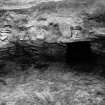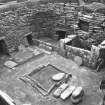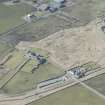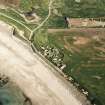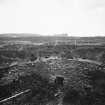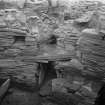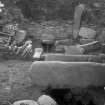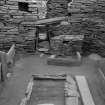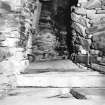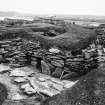Pricing Change
New pricing for orders of material from this site will come into place shortly. Charges for supply of digital images, digitisation on demand, prints and licensing will be altered.
Skara Brae
Midden (Neolithic), Settlement (Neolithic)
Site Name Skara Brae
Classification Midden (Neolithic), Settlement (Neolithic)
Alternative Name(s) Skerrabrae; Skea Brae; Bay Of Skaill; Skaill House; Skail Bay
Canmore ID 1663
Site Number HY21NW 12
NGR HY 23125 18745
Datum OSGB36 - NGR
Permalink http://canmore.org.uk/site/1663
First 100 images shown. See the Collections panel (below) for a link to all digital images.
- Council Orkney Islands
- Parish Sandwick
- Former Region Orkney Islands Area
- Former District Orkney
- Former County Orkney
The Neolithic settlement at Skara Brae consists of drystone structures linked by paved passageways. Most are built within a mound of midden material that has been packed up against the outer walls, resulting in a semi-subterranean arrangement. Each house is furnished in a similar fashion using stone slabs with repeated elements including central hearths, box-beds and shelved 'dressers'. An exception is House 8, a freestanding building, which may have been used as a workshop.
Remains of at least ten structures have been recorded, but these were not contemporary. The village may have been in use for around five hundred years, the well preserved houses that are currently visible representing the latest phase of rebuilding and occupation.
Information from RCAHMS (SC) 22 June 2007
Ritchie, A 1995
Ritchie, A and Ritchie, G 1998
HY21NW 12.00 23125 18745
(HY 2313 1874) Skerrabrae (NR)
OS 6" map, Orkney, 2nd ed., (1903).
See also HY21NW 30.00, HY21NW 30.01 and HY21NW 36.
HY21NW 12.01 HY 231 187 Stone: Rune-Inscribed
HY21NW 12.02 HY 230 187 Animal Remains; Stone Knives; Hearth
HY21NW 12.03 HY 230 187 Burial; Midden
For comparable settlements at Barnhouse (Mainland), Rinyo (Rousay) and Pool (Sanday), see HY31SW 61-2, HY43SW 20 and HY63NW 17 respectively.
Skara Brae, a Neolithic/Early Bronze Age settlement dated from its close similarity to the settlement at Rinyo (HY43SW 20), is a cluster of seven huts, connected by covered alleys, all contained within a heap of midden material. There are three phases of occupation, all of similar nature. The buildings are of drystone construction. They had been covered with blown sand, in which were found two stone cists containing pagan, probably Norse, inhumations. (For full details see authorities).
V G Childe 1950; RCAHMS 1946.
The settlement at Skara Brae is as described, planned and illustrated by the above authorities.
Resurveyed at 1/2500.
Visited by OS (NKB) 25 May 1967
HY 231 187. Excavations were undertaken on behalf of the Department of the Environment, 25m W of the present guardianship area where a storm had revealed the remains of a wall. The walling forms part of a structure or structures of a type not previously documented at the site. Two phases are represented and the line of the walling of each phase diverges as they go inland, becoming two separate walls. Both have walling running at right angles to the main walls. Preservation is extermely partial ranging from substantial walling several courses high to a single stone continuing the line. No significant midden deposits were associated with either phase of walling.
D V Clarke 1977
Radiocarbon Dates:
Birm 436 End of phase II village Mixed animal bone 2090bc +-110
2655BC +-125
Birm 434 End pf phase II village Mixed animal bone 2070bc +-110
2625BC +-125
Birm 435 End of phase II village Mixed animal bone 1920bc +-100
2415BC +-115
Birm 433 End of phase II village Mixed animal bone 1880bc +-100
2355BC +-125
Birm 793 Base of waterlogged layer in midden deposits at periphery of domestic area Mixed animal bone 2110bc +-130
2685BC +-145
Birm 477 Base of waterlogged layer in midden deposits at periphery of domestic area Mixed animal bone 2000bc +-100
2520BC +-115
Birm 478 Top of waterlogged layer in midden deposits at periphery of domestic area Mixed animal bone 2190bc +-120
2830BC +-135
Birm 792 Top of waterlogged layer in midden deposits at periphery of domestic area Mixed animal bone 1980bc +-110
2495BC +-125
Birm 437 Top of waterlogged layer in midden deposits at periphery of domestic area Mixed animal bone 1830bc +-110
2275BC +-125
Birm 795 Occupation deposits on old land surface Mixed animal bone
2520bc +-120 3270BC +-135
Birm 480 Occupation deposits on old land surface Mixed animal bone
2370bc +-100 3055BC +-135Birm 794
Occupation deposits on old land surface Mixed animal bone
2330bc +-100 3005BC +-115
Birm 637 Beginning of Phase I village Mixed animal bone
2480bc +-100 3215BC +-115
Birm 638 Beginning of phase I village Mixed animal bone
2480bc +-120 3215BC +-135
Birm 639 Beginning of phase I village Mixed animal bone
2450bc +-100 3175BC +-115
Birm 636 Beginning of phase I village Mixed animal bone
2400bc +-130 3095BC +-145
Birm 790 End of phase I village Mixed animal bone
2420bc +-150 3125BC +-160
Birm 789 End of phase I village Mixed animal bone
2360bc +-120 3045BC +-135
Birm 791 End of phase I village Mixed animal bone
2340bc +-100 3020BC +-115
Birm 788 Beginning of phase II village Mixed animal bone
2340bc +-120 3020BC +-135
Birm 786 Beginning of phase II village Mixed animal bone
2330bc +-120 3005BC +-135
Birm 787 Beginning of phase II village Mixed animal bone
2200bc +-100 2850BC +-115
J L Davidson and A S Henshall 1989.
HY 231 187 A watching brief was conducted at the Neolithic settlement of Skara Brae (NMRS HY21NW 12) between February and March 2000. The work to be monitored was the removal of fence posts and their concrete settings around the S and E of the site, and the excavation of a trench and holes for a new perimeter fence and rabbit netting. Naturally accumulated sand deposits were most common, with occasional buried ground horizons. However, close to the S side of House 7, midden deposits were observed. A bone point, two cobble tools and six Skaill knives were retrieved.
Further archaeological monitoring of a substantial deturfing exercise to create a new footpath was carried out in April 2000. The turf was cut partly by hand and partly by machine. In both of the excavated trenches, the depth of excavation did not penetrate beneath archaeologically insensitive topsoil material. Consequently, no finds were recorded or retained.
Sponsor: Historic Scotland.
P Sharman and D Stewart 2000.
Scheduled as 'Skara Brae, settlement, mounds and other remains [comprising] the Neolithic village at Skara Brae, nearby remains of structures and activity areas of similar date, a large mound containing a succession of prehistoric and early medieval structures, and an area in which related remains are likely to survive, including ancient soils and field systems'.
Information from Historic Scotland, scheduling document dated 2 February 2004.
'The Orcadian' newspaper makes a number of references to Skara Brae. In 1866 it described the donations from 1863, from the site, given to the scottish Antiquarian Museum, and discussed the excavations being carried out at Skara Brae. In 1882 2 stone balls from the site were mentioned.
Standing building recording HY 2313 1874 A continuing programme of survey between February and November 2005 included stone-by-stone recording of the passageways and other areas not completed by an earlier photogrammetric survey, and the identification and positioning of inscribed stones (on-site).
Archive to be deposited in NMRS.
Sponsor: HS.
D Sproat 2005
Watching brief HY 2316 1875 A watching brief was undertaken in September 2005 during minor excavations near the NE entrance gate to the Neolithic village to allow access to a telephone cable. Only ground previously disturbed and redeposited during the original installation of the cable was disturbed. No finds, deposits or structures of archaeological significance were encountered in this small excavation.
Archive to be deposited in NMRS.
Sponsor: HS.
A Hollinrake 2005
HY 2311 1873 A watching brief was undertaken in March and April 2006 during the lifting of turf and paving slabs as part of a programme of works to alter visitor access paths in and around Skara Brae Neolithic Village. These works did not penetrate beyond turf and topsoil in any of the excavated areas, and as a result, no deposits, finds or structures of archaeological significance were encountered.
Archive deposited with Orkney SMR held at Orkney College, Kirkwall, Orkney. Archive to be deposited in NMRS.
Sponsor: Historic Scotland.
A Hollinrake 2006.
Reference (1850)
In the winter of 1850 an extremely severe storm stripped the grass from the high dune known as Skara Brae in the south corner of the Bay of Skail. The storm exposed an immense midden mound or refuse heap and the ruins of ancient dwellings.
D Clarke and P Maguire 1989
Antiquarian Observation (1850 - 1868)
The Laird of Skaill, William Watt, began to explore the site and by 1868, four of the houses had been cleared out and a very rich collection of objects had been lodged in Skaill House.
Antiquarian Observation (1865 - 1867)
Reference (1866 - 1882)
'The Orcadian' newspaper makes a number of references to Skara Brae. In 1866 it described the donations from 1863, from the site, given to the Scottish Antiquarian Museum, and discussed the excavations being carried out at Skara Brae. In 1882 two stone balls from the site were mentioned.
The Orcadian 1971; 1972; 1973.
Photographic Record (1924)
Incident (1925)
A storm washed away part of the midden mound and damaged part of the previously cleared structures.
Conservation (1925 - 1927)
The seawall was built and buildings strengthened and consolidated. Further undisturbed structures were discovered.
Excavation (1927 - 1930)
Skara Brae, a Neolithic/Early Bronze Age settlement dated from its close similarity to the settlement at Rinyo (HY43SW 20), is a cluster of seven huts, connected by covered alleys, all contained within a heap of midden material. There are three phases of occupation, all of similar nature. The buildings are of drystone construction. They had been covered with blown sand, in which were found two stone cists containing pagan, probably Norse, inhumations. (For full details see authorities).
V G Childe 1950; RCAHMS 1946.
Photographic Survey (31 May 1956)
Photographic Survey (22 July 1957 - 23 July 1957)
Photographic Record (1963)
Field Visit (25 May 1967)
The settlement at Skara Brae is as described, planned and illustrated by the above authorities.
Resurveyed at 1/2500.
Visited by OS (NKB) 25 May 1967
Aerial Photography (1971)
Oblique aerial photographs of Skara Brae by John Dewar in 1971
Excavation (1972 - 1973)
Excavations were undertaken on behalf of the Department of the Environment, 25m west of the present guardianship area where a storm had revealed the remains of a wall.
Salvage Record (16 September 1978)
Radiocarbon Dating (1989)
Radiocarbon Dates:
Birm 436 End of phase II village Mixed animal bone 2090bc +-110
2655BC +-125
Birm 434 End pf phase II village Mixed animal bone 2070bc +-110
2625BC +-125
Birm 435 End of phase II village Mixed animal bone 1920bc +-100
2415BC +-115
Birm 433 End of phase II village Mixed animal bone 1880bc +-100
2355BC +-125
Birm 793 Base of waterlogged layer in midden deposits at periphery of domestic area Mixed animal bone 2110bc +-130
2685BC +-145
Birm 477 Base of waterlogged layer in midden deposits at periphery of domestic area Mixed animal bone 2000bc +-100
2520BC +-115
Birm 478 Top of waterlogged layer in midden deposits at periphery of domestic area Mixed animal bone 2190bc +-120
2830BC +-135
Birm 792 Top of waterlogged layer in midden deposits at periphery of domestic area Mixed animal bone 1980bc +-110
2495BC +-125
Birm 437 Top of waterlogged layer in midden deposits at periphery of domestic area Mixed animal bone 1830bc +-110
2275BC +-125
Birm 795 Occupation deposits on old land surface Mixed animal bone
2520bc +-120 3270BC +-135
Birm 480 Occupation deposits on old land surface Mixed animal bone
2370bc +-100 3055BC +-135Birm 794
Occupation deposits on old land surface Mixed animal bone
2330bc +-100 3005BC +-115
Birm 637 Beginning of Phase I village Mixed animal bone
2480bc +-100 3215BC +-115
Birm 638 Beginning of phase I village Mixed animal bone
2480bc +-120 3215BC +-135
Birm 639 Beginning of phase I village Mixed animal bone
2450bc +-100 3175BC +-115
Birm 636 Beginning of phase I village Mixed animal bone
2400bc +-130 3095BC +-145
Birm 790 End of phase I village Mixed animal bone
2420bc +-150 3125BC +-160
Birm 789 End of phase I village Mixed animal bone
2360bc +-120 3045BC +-135
Birm 791 End of phase I village Mixed animal bone
2340bc +-100 3020BC +-115
Birm 788 Beginning of phase II village Mixed animal bone
2340bc +-120 3020BC +-135
Birm 786 Beginning of phase II village Mixed animal bone
2330bc +-120 3005BC +-135
Birm 787 Beginning of phase II village Mixed animal bone
2200bc +-100 2850BC +-115
J L Davidson and A S Henshall 1989.
Publication Account (1996)
The west coast of Orkney is mostly very rugged, with high cliffs and pounding Atlantic waves prohibiting coastal settlement, and the only shelter to be found is in the three bays of Birsay, Marwick and Skaill. But the size and shape of these bays has been altered by erosion over the centuries, and the settlement of Skara Brae, when it was founded some 5000 years ago, was certain ly not on the shore as it is now but set well back from the sea. Environmental evidence even suggests that a freshwater loch, like the Loch of Skaill behind Skaill House, may have separated the site from the sea and its immediate sandy shore. The name Skara Brae was originally coined to describe the huge sand-dune that covered the site until storm damage in 1850 revealed the presence of stone structures and midden deposits, and, although erosion has destroyed the northern margin of the settlement, it seems likely that the impression given by the visible surviving remains is essentially accurate: this was, architecturally and socially, a tightly knit housing complex for a small community of perhaps fifty people.
Radiocarbon dating suggests that Skara Brae was inhabited for around 600 years, during which time there was rebuilding and modification of the houses and intercon necting passages, and inevitably most of the structures visible today represent the final layout of the village. Its focus consists of six square or rectangular houses linked by narrow irregular passages, very much an inwardlooking complex, with a single isolated building of somewhat different design on the west side of the village. The evidence of burnt stones and chips of chert found in this building (no. 8) suggests that it was not an ordinary house but a workshop, probably where chert tools were manufactured (chert was used as a substitute for flint, which in Orkney occurs only as relatively small nodules washed up on the shore). The main group of domestic houses has two remarkable characteristics: embedded in midden, it is virtually subterranean, and the internal design of its housing units has a standard uniformity. Both aspects were deliberate and, assuming that there was no prehistoric equivalent of a modern building contractor at work here, they must indicate a very strong sense of corporate identity amongst the families of this community.
Each house consists of a single room with thick drystone walls surviving in some places as high as 3m. There is a marked contrast between the cramped conditions of the passageways and the equally low and narrow doorways and the spacious and comfortable house-interiors, again a contrast that must have been deliberate and which mirrors the design of contemporary tombs with their low tunnel-like passages and soaring chambers. It is as if the idealogy of their builders demanded that getting there should be humiliatingly difficult but living there, whether in life or death, should be glorious. Small cells were built into the walls, mostly for storage but some furnished with drains as lavatories. A large square earth with stone kerbs occupies the centre of each house, and the use of stone slabs to build furniture has left us with an unusually precise picture of how the rest of the room was arranged (best seen in nos 1 and 7): slabbuilt beds flanked either side of the hearth, and a stone dresser was built against the wall opposite the door. Wall cupboards and stone boxes sunk into the floor provide extra storage space. To these bare essentials the visitor's eye should add heather and furs to the beds, skin canopies spanning the bed-posts, decorative pottery jars to the dresser, flame to the hearth, dried meats and fish hanging from the rafters...
Traces of earlier houses suggest a greater variety of plan and perhaps less sophisticated interior design: no. 9 is the most complete, and it has a central hearth and bed-alcoves built into the thickness of the walls. Without demolishing the later houses, it is impossible to reconstruct the appearance of the original village, but the basic economy and material culture of the community seems to have changed little over the centuries, suggesting that the overall form of the settlement probably also remained the same. A self-sufficient life-style was based on animal husbandry, fishing and cereal cultivation, with thriving local manufacture of stone and bone tools and of thick pottery jars known as Grooved Ware, often decorated in relief with spirals, bosesand linear motifs. There is a small site museum (where an excellent official guidebook is sold) and other finds from the excavations are in Stromness Museum and Tankerness House Museum, although the bulk of the material is in NMS.
Information from ‘Exploring Scotland’s Heritage: Orkney’, (1996).
Watching Brief (27 April 2000 - 28 April 2000)
Archaeological monitoring of a substantial deturfing exercise was carried out at Skara Brae in April 2000. The purpose of the deturfing was to create a new footpath to improve access from the visitor centre to the site via a new entrance through the perimeter fence at the E side of the monument. The turf was cut partly by hand and partly by machine. In both of the excavated trenches, the depth of excavation did not penetrate beneath archaeologically insensitive topsoil material. Consequently, no finds were recorded or retained.
Sponsor: Historic Scotland
P Sharman & D Stewart 2000
Kirkdale Archaeology
Watching Brief (28 February 2000 - 6 March 2000)
HY 231 187 A watching brief was conducted at the Neolithic settlement of Skara Brae (NMRS HY21NW 12) between February and March 2000. The work to be monitored was the removal of fence posts and their concrete settings around the S and E of the site, and the excavation of a trench and holes for a new perimeter fence and rabbit netting. Naturally accumulated sand deposits were most common, with occasional buried ground horizons. However, close to the S side of House 7, midden deposits were observed. A bone point, two cobble tools and six Skaill knives were retrieved.
Further archaeological monitoring of a substantial deturfing exercise to create a new footpath was carried out in April 2000. The turf was cut partly by hand and partly by machine. In both of the excavated trenches, the depth of excavation did not penetrate beneath archaeologically insensitive topsoil material. Consequently, no finds were recorded or retained.
P Sharman and D Stewart 2000
Sponsor: Historic Scotland
Kirkdale Archaeology
Standing Building Recording (February 2005 - November 2005)
A continuing programme of survey between February and November 2005 included stone-by-stone recording of the passageways and other areas not completed by an earlier photogrammetric survey, and the identification and positioning of inscribed stones (on-site).
Watching Brief (September 2005)
A watching brief was undertaken in September 2005 during minor excavations near the NE entrance gate to the Neolithic village to allow access to a telephone cable.
Watching Brief (March 2006 - April 2006)
HY 2311 1873 A watching brief was undertaken in March and April 2006 during the lifting of turf and paving slabs as part of a programme of works to alter visitor access paths in and around Skara Brae Neolithic Village. These works did not penetrate beyond turf and topsoil in any of the excavated areas, and as a result, no deposits, finds or structures of archaeological significance were encountered.
Archive deposited with Orkney SMR held at Orkney College, Kirkwall, Orkney. Archive to be deposited in NMRS.
Sponsor: Historic Scotland.
A Hollinrake 2006
Watching Brief (March 2007)
HY 2312 1873 During March 2007 a watching brief was maintained during the excavation of material from behind the sea wall just to the E of Skara Brae Neolithic Village. During recent severe weather, areas of subsidence had appeared in two small areas just to the inland side of the far E end of the concrete wall. As anticipated, the ground behind the wall was seen to be imported material, mostly large stones and sand from the beach. No finds or features of archaeological significance were seen during this work.
Archive deposited with Orkney SMR. Archive to be deposited with RCAHMS.
Watching Brief (29 May 2007)
HY 2311 1872 On 29 May 2007 five small test pits were excavated around the glass roof covering House 7 at Skara Brae Neolithic Village. This was required to make sure that the removal of turf and topsoil during the removal of the glass roof from over House No 7 would not disturb any sensitive archaeological features. Only the concrete base of the glass roof and sand were revealed. There were no finds or features of archaeological significance revealed during this work.
Archive deposited with Orkney SMR. Archive to be deposited with RCAHMS.
Funder: Historic Scotland.
Watching Brief (6 October 2008)
HY 2318 1874 and HY 2340 1880 A watching brief was undertaken during the excavation of two small holes near Skara Brae on 6 October 2008. The first was for the relocation of a sign next to the access path near the village, while the second was for the placement of a new stone in the ‘Timeline’ at the end of the path nearest the visitor centre. Only turf, topsoil and underlying sand were disturbed and there were no finds or features of archaeological significance.
Archive: RCAHMS (intended)
Funder: Historic Scotland
Andrew Hollinrake – Kirkdale Archaeology
OASIS ID - kirkdale1-249695
Environmental Sampling (January 2018 - September 2018)
HY 2319 1871 The changing landscape of Skara Brae, in the Bay of Skaill, is well known. This project was instigated to seek clarity relating to the precise configuration of the landscape during construction and occupancy of the site and processes of landscape change in particular relating to rising relative sea-levels and the influence of the marine environment. Three fieldwork seasons in January, May and September 2018 established that the intertidal peat beds recorded by previous projects are no longer extant.
Electromagnetic ground conductivity survey across the fields between the Loch of Skaill and the coast was supplemented by the recovery of sediment samples from boreholes obtained using a vibrocorer and hand augering. Cores were taken across the loch, from the reedbeds to the N of the loch and immediately to the E of Skara Brae.
Cores were scanned using an Itrax micro-XRF core scanner. Samples were analysed for organic, carbonate, and inorganic material content. Ostracods and other notable remains (molluscs, insects etc) were counted.
Final analysis of the results remains to be completed but, in general, the dynamic nature of the environment occupied by the community at Skara Brae is confirmed. The research highlights a series of discrete local depositional environments across the area including local marshland. The freshwater environment of the Loch of Skaill flows N towards the coast through a narrow channel which has only periodically been penetrated by low brackish waters. There is no significant evidence that marine waters flooded into the basin at any time. Increasing sand deposition throughout the life of the settlement is indicated, with concomitant impact on agriculture.
Archive: Currently with contributors; NRHE, Orkney HER and ADS (intended)
Funder: Historic Environment Scotland
M Bates, R Bates, S Davies, J Whittaker, S Dawson, CR Wickham-Jones – University of Wales, Trinity St David, University of St Andrews, University of Dundee, and University of Aberdeen
(Source DES Volume 19)





















































































































